Lecture3-口译笔记法资料
- 格式:ppt
- 大小:718.00 KB
- 文档页数:72

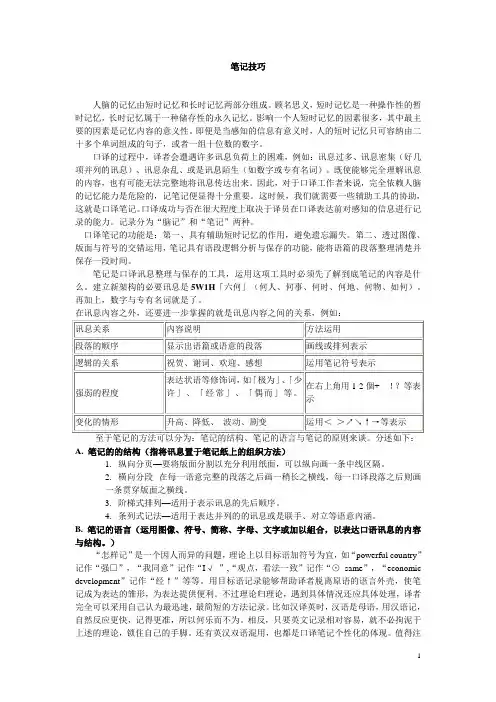
笔记技巧人脑的记忆由短时记忆和长时记忆两部分组成。
顾名思义,短时记忆是一种操作性的暂时记忆,长时记忆属于一种储存性的永久记忆。
影响一个人短时记忆的因素很多,其中最主要的因素是记忆内容的意义性。
即便是当感知的信息有意义时,人的短时记忆只可容纳由二十多个单词组成的句子,或者一组十位数的数字。
口译的过程中,译者会遭遇许多讯息负荷上的困难,例如:讯息过多、讯息密集(好几项并列的讯息)、讯息杂乱、或是讯息陌生(如数字或专有名词)。
既使能够完全理解讯息的內容,也有可能无法完整地将讯息传达出来。
因此,对于口译工作者来说,完全依赖人脑的记忆能力是危险的,记笔记便显得十分重要。
这时候,我们就需要一些辅助工具的协助,这就是口译笔记。
口译成功与否在很大程度上取决于译员在口译表达前对感知的信息进行记录的能力。
记录分为“脑记”和“笔记”两种。
口译笔记的功能是:第一、具有辅助短时记忆的作用,避免遗忘漏失。
第二、透过图像、版面与符号的交错运用,笔记具有语段逻辑分析与保存的功能,能将语篇的段落整理清楚并保存一段时间。
笔记是口译讯息整理与保存的工具,运用这项工具时必须先了解到底笔记的內容是什么。
建立新架构的必要讯息是5W1H「六何」(何人、何事、何时、何地、何物、如何)。
再加上,数字与专有名词就是了。
在讯息內容之外,还要进一步掌握的就是讯息內容之间的关系,例如:A. 笔记的的结构(指将讯息置于笔记纸上的组织方法)1. 纵向分页—要将版面分割以充分利用纸面,可以纵向画一条中线区隔。
2. 橫向分段--在每一语意完整的段落之后画一稍长之横线,每一口译段落之后则画一条贯穿版面之横线。
3. 阶梯式排列—适用于表示讯息的先后顺序。
4. 条列式记法—适用于表达并列的的讯息或是联手、对立等语意內涵。
B. 笔记的语言(运用图像、符号、简称、字母、文字或加以組合,以表达口语讯息的内容与结构。
)“怎样记”是一个因人而异的问题,理论上以目标语加符号为宜,如“powerful country”记作“强□”,“我同意”记作“I√”,“观点,看法一致”记作“⊙same”,“economic development”记作“经↑”等等。

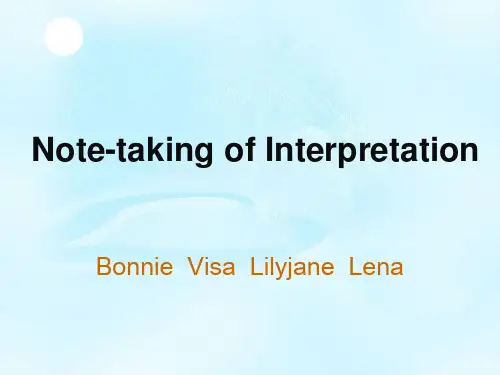
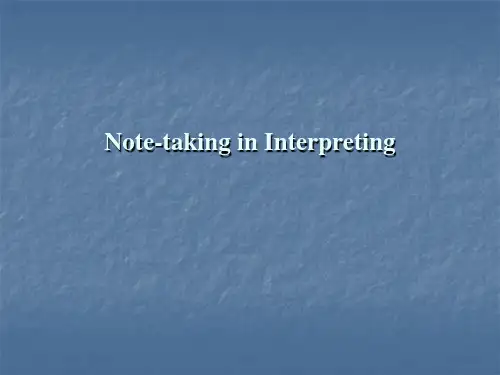


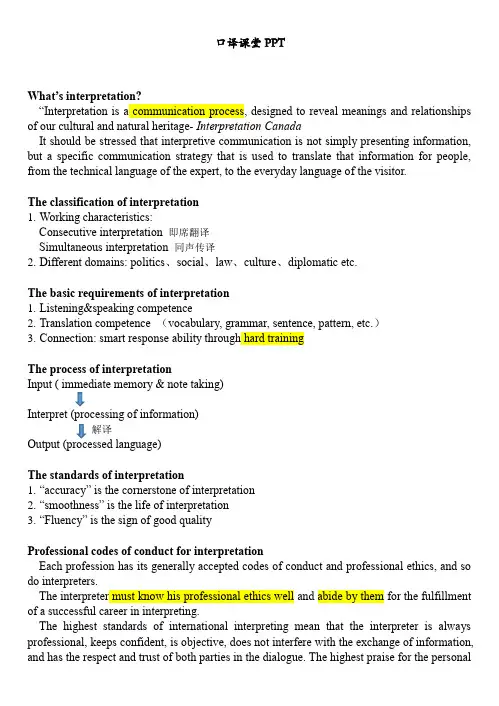
口译课堂PPTWhat’s interpretation?“Interpretation is a communication process, designed to reveal meanings and relationships of our cultural and natural heritage-Interpretation CanadaIt should be stressed that interpretive communication is not simply presenting information, but a specific communication strategy that is used to translate that information for people, from the technical language of the expert, to the everyday language of the visitor.The classification of interpretation1.Working characteristics:Consecutive interpretation 即席翻译Simultaneous interpretation 同声传译2.Different domains: politics、social、law、culture、diplomatic etc.The basic requirements of interpretation1.Listening&speaking competence2.Translation competence (vocabulary, grammar, sentence, pattern, etc.)3.Connection: smart response ability through hard trainingThe process of interpretationInterpret (processing of information)解译The standards of interpretation1.“accuracy” is the cornerstone of interpretation2.“smoothness” is the life of interpretation3.“Fluency” is the sign of good qualityProfessional codes of conduct for interpretationEach profession has its generally accepted codes of conduct and professional ethics, and so do interpreters.The interpreter must know his professional ethics well and abide by them for the fulfillment of a successful career in interpreting.The highest standards of international interpreting mean that the interpreter is always professional, keeps confident, is objective, does not interfere with the exchange of information, and has the respect and trust of both parties in the dialogue. The highest praise for the personalinternational figures is that nobody has notices their presence.1.Professional confidenceThe interpreter has the obligation never to release any secret which he/she has come to know through the performance of his work. This is extremely important.2.Sufficient preparationAs early as possible before an assignment, the interpreter should acquire a very complete file of the documents which will come up for discussion both in the source language and in the target language.1) Advanced preparationBefore the meeting, the interpreter should ask the conference organizer to provide a full set of documents, which include the conference programmer, list of participants, background information about the conference, and most important, documents on the content of the conference (including drafts of papers to be read or presented, abstracts, etc.)Briefings are potentially a very useful part of advanced preparation. They are meetings organized for the interpreter, with the participation of the organizer and experts in the field. At the briefing, general information is given to the interpreter, who can ask specific questions, generally on concepts and terminology.2) Last minute preparationFor organizational reasons, the conference documents are not always available before the conference.Sometimes, many documents are only available at the very last moment, yet a acquisition may revolve around them. The interpreter should be ready to deal with the situation.3) In-conference preparationMuch information is gained during the conference itself, partly through documents which are only handed out after the meeting has started, partly through conversation with participants during break, and partly through the content of presentations and discussions.3. Conference-room mannerIn meetings, the interpreter should match the general average in dress an thus be inconspicuous.4. Personal qualifications and assignmentsIt is the responsibility of the interpreter to find out about the exact character of an assignment before accepting it.5. Doubts and mistakesOn some occasions, particularly in technical discussion, the interpreter will come across words for which he/she does not know the right translation. In this situation, he/she should tryto give a clear paraphrase to explain it. If this cannot be done, he/she should be frank to admit his/she ignorance and try to seek help from whatever source available.If the interpreter makes a mistake, he/she should correct it immediately without feeling shy or worrying about losing face. If the speaker or a listener corrects a mistake made by the interpreter, the interpreter should always be ready to accept the correction, apologize and thank briefly. Even when the corrections are wrong, the interpreter should remain polite and explain later instead of embarking on a discussion.6. Maintain professional confidentialityThe interpreter’s work often makes him/her the unwanted and unavoidable sharer of secrets belongings to groups or individuals in international gatherings. Not only should the interpreter never intentionally discuss or volunteer information about sensitive material that he/she has had access to in work, but the interpreter should also take the greatest care to leak out apparently harmless which might be highly sensitive in some quarters.第一讲:口译技能训练之公共场合讲话Public SpeakingIn interpreting, the interpreter transmits the message through spoken language, which is spontaneous, instantaneous, and ephemeral. Spontaneity arises from the need to interpret as one hears the source message, and the interpretation is instantaneous in the sense that there is little time to prepare. Everything which is said is ephemeral: there is little possibility of a playback or analysis. Therefore clarity is essential so that the listeners have the maximum chance of understanding what the interpreter says.The interpreter should make a point of making his voice carry well so that the audience-even those sitting at the back of a large meeting room-can hear clearly.Voice Projection (some tips)1)Speak with a clear, firm voice, the first few sentences are especially important to convey assurance to your audience;2)Be clearly intelligible at all times; pronounce proper names and titles especially carefully;3)Don’t “orate”, but do sound natural and sincere;4)Use the first person singular;5)Talk to your audience”personally” and keep contact with them at all times;6)Watch the reaction of the audience to what you say;7)Be friendly toward your audience, be interested in your subject;8)Don’t frown;9)Don’t grimace, even if you make mistakes.Speed of deliveryPublic speaking for an interpreter means that you have to maintain the interest of the audience,who are hearing a text twice, once in a version which they cannot understand. You must engage their attention, and one method is to vary your speed of delivery.More tips:1)Don’t talk faster than 160 words a minute or slower than 90 words a minute;2)Keep your rate of delivery constantly changing;3)Don’t be monotonous in your delivery;4)Change your pace or speed in response to the audience’s reactions;5)Allow space for applause, laughter, or interruptions;6)Keep eye contact with the audience.第二讲:口译技能训练之记忆训练Memory trainingThe importance of a good memory in interpretingThe ability to process information is an essential part of successful interpreting. The ability to listen, comprehend, and retain information is necessary for processing information. Theory:As Wolfgang Zoelke pointed out in his popular work, Conditioning your memory, “Memory is no local function in the brain and definitely not a type of container. Memory is rather the entire body of thought which you retain,” and “memory is the lasting functioning of many mechanical, sensory, mental and physical moments.”Short-term Memory:The duration of STM is very short. It is up 6 to 30 seconds. Memory in interpreting only lasts for a short time. Once the interpreting assignment is over, the interpreter moves on to another one, often with different context, subject and speakers.Long-term Memory:Long-term Memory occurs when you have created neural pathways for storing ideas and information which can then be recalled weeks, months, or even years later. To create these pathways, you must make a deliberate attempt to encode the information in the way you intend to recall it later. Long-term memory is a learning process. And it is essentially an important part of the interpreter’s acquisition of knowledge, because information stored in LTM may last for minutes to weeks, months, or even an entire life.Short-term memory trainingShadowing 影子练习ParrotingChinese Whispers Simultaneous shadowing Lagging shadowing Multi-taskingLong-term memory trainingInformation-VisualizationThis is to visualize what the speaker is saying in interpretation. It is applicable to the retaining of information in such speech types as narration, description and introduction.Encoding, storage and retrievalCategorization, generalization and comparison提纲式记忆指译员充分利用语篇的基本结构及其主要意义间的联系,把源语材料内容当做提纲或框架来处理。
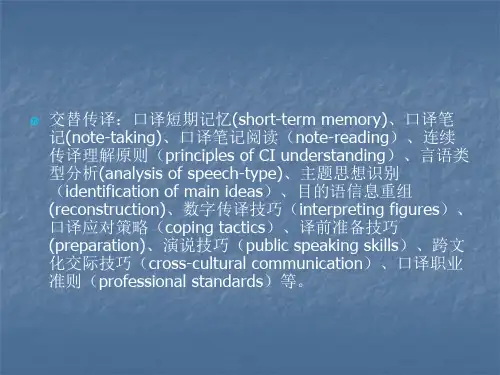
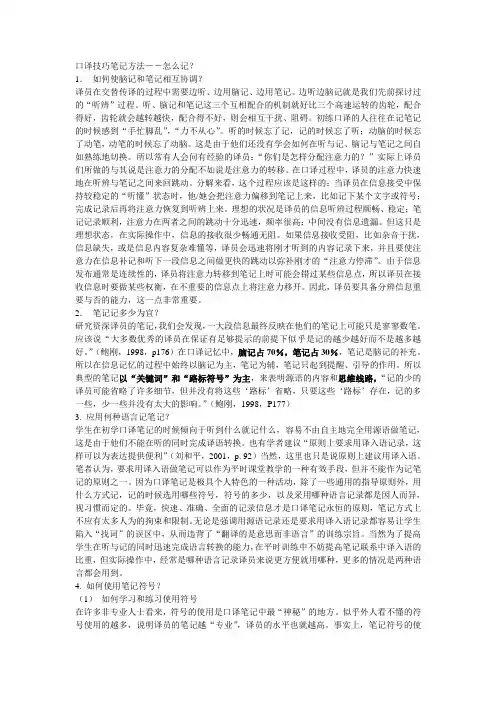
口译技巧笔记方法――怎么记?1.如何使脑记和笔记相互协调?译员在交替传译的过程中需要边听、边用脑记、边用笔记。
边听边脑记就是我们先前探讨过的“听辨”过程。
听、脑记和笔记这三个互相配合的机制就好比三个高速运转的齿轮,配合得好,齿轮就会越转越快,配合得不好,则会相互干扰、阻碍。
初练口译的人往往在记笔记的时候感到“手忙脚乱”,“力不从心”。
听的时候忘了记,记的时候忘了听;动脑的时候忘了动笔,动笔的时候忘了动脑。
这是由于他们还没有学会如何在听与记、脑记与笔记之间自如熟练地切换。
所以常有人会问有经验的译员:“你们是怎样分配注意力的?”实际上译员们所做的与其说是注意力的分配不如说是注意力的转移。
在口译过程中,译员的注意力快速地在听辨与笔记之间来回跳动。
分解来看,这个过程应该是这样的:当译员在信息接受中保持较稳定的“听懂”状态时,他/她会把注意力偏移到笔记上来,比如记下某个文字或符号;完成记录后再将注意力恢复到听辨上来。
理想的状况是译员的信息听辨过程顺畅、稳定;笔记记录顺利,注意力在两者之间的跳动十分迅速,频率很高;中间没有信息遗漏。
但这只是理想状态,在实际操作中,信息的接收很少畅通无阻。
如果信息接收受阻,比如杂音干扰,信息缺失,或是信息内容复杂难懂等,译员会迅速将刚才听到的内容记录下来,并且要使注意力在信息补记和听下一段信息之间做更快的跳动以弥补刚才的“注意力停滞”。
由于信息发布通常是连续性的,译员将注意力转移到笔记上时可能会错过某些信息点,所以译员在接收信息时要做某些权衡,在不重要的信息点上将注意力移开。
因此,译员要具备分辨信息重要与否的能力,这一点非常重要。
2.笔记记多少为宜?研究资深译员的笔记,我们会发现,一大段信息最终反映在他们的笔记上可能只是寥寥数笔。
应该说“大多数优秀的译员在保证有足够提示的前提下似乎是记的越少越好而不是越多越好。
”(鲍刚,1998,p176)在口译记忆中,脑记占70%,笔记占30%,笔记是脑记的补充。
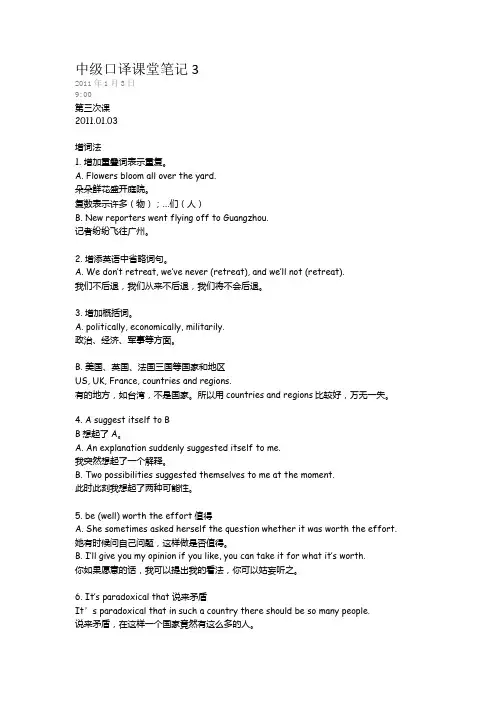
中级口译课堂笔记32011年1月3日9:00第三次课2011.01.03增词法1. 增加重叠词表示重复。
A. Flowers bloom all over the yard.朵朵鲜花盛开庭院。
复数表示许多(物);…们(人)B. New reporters went flying off to Guangzhou.记者纷纷飞往广州。
2. 增添英语中省略词句。
A. We don’t retreat, we’ve never (retreat), and we’ll not (r etreat).我们不后退,我们从来不后退,我们将不会后退。
3. 增加概括词。
A. politically, economically, militarily.政治、经济、军事等方面。
B. 美国、英国、法国三国等国家和地区US, UK, France, countries and regions.有的地方,如台湾,不是国家。
所以用countries and regions比较好,万无一失。
4. A suggest itself to BB想起了A。
A. An explanation suddenly suggested itself to me.我突然想起了一个解释。
B. Two possibilities suggested themselves to me at the moment.此时此刻我想起了两种可能性。
5. be (well) worth the effort 值得A. She sometimes asked herself the question whether it was worth the effort. 她有时候问自己问题,这样做是否值得。
B. I’ll give you my opinion if you like, you can take it for what it’s worth.你如果愿意的话,我可以提出我的看法,你可以姑妄听之。
Unit Three: Friendship Word BankGood Usage (Para. 1)approach the notion offirmly agreed and socially acknowledged criteria fordescribe…asin one setting, …. in anothera very thin understanding ofsome classical views ofGood Usage (Para. 2)distinguishes between…mutual usefulnessGood Usage (Para. 3)based on utilitychange according to circumstancesbreak upkeep it aliveare pursuing one’s own advantagefeel no need ofmutually usefultake pleasure in each other’s companyin so far as…have hopes of advantage fromGood Usage (Para.4)be grounded on pleasurethe opportunity of the momentquick to make and to break friendshipsfall in and out of friendshipwithin the same day realize the object of...Good Usage (Para.5)based on goodnesseach loves the other for what he isin the highest formas the saying goesgo through trials and tribulations together is worthy of lovewon his trustGood Usage (Para.6) defines…as…leave no question as to…are free fromhave the courage of their convictions possess any superiorityregard…as equalsbe annoyed atbeing surpassed in genius, fortune, or rank Good Usage (Para.7)enjoy each other’s companyshare a commitment tovirtuous friendsare bound togethermoral excellencealtruistic emotionsdevelop a shared idea ofKey Words and Expressions for Text Adescribe…asstate sb. / sth. to be sb. / sth.; call 把……叫做;称作e. g. 1. He describes himself as a doctor; but in fact, he knows little about medicine.2. I hesitate to describe him as really clever.我很难说他真聪明。
↑:表示“增长,扩大,提高,加强,上涨,提拔”等意义相连的意思;↓:表示“下跌,下降,减少,恶化,降职”等意思;←:表示“源于,进口,收到,回归”等意思;→:表示“出口,输出,打入,出国,到达,屈服于,导致”等意义。
数学符号“+”: 表示“加上,另外,除此之外”;“-”:表示“减去,缺乏等”;“×”表示“不对的,错的,坏的,臭名昭著的”;“∵”表示“由于,因为”;“∴”则表示“所以,因此,结果”等。
“:”表示“问题,疑问,问等”意思;“。
”可以用来表示“观点,意见,论点,难点等”。
举例说“我想说几点”就可以用符号表示为“I:几。
”。
而且“。
”还可以用来表示不同的时间概念,如“去年”可以表示为“。
y”,而明天则为“d。
”;“()”则表示“包括;封闭;在…之内”等意思。
“√”可以表示“正确;好;有名的;同意”等;“⊙”可以代表“会议;研讨会;讨论;谈判”等与会议有关的词汇;因为符号的形状很容易让人联想到开会的桌子。
“o”可以代表“人”;如“科学家”就可以记为“So”;“∧”可以表示“领导,管理”,因此,如“领导人”就可以结合上面的符号记为“∧o”;“#”代表讲话的结束;“﹠”表示“和谁…在一起,陪同”等意思;“△”则可以表示“代表”;“□”代表“国家”,而“﹥﹤”可以表示“对立,冲突”等意思的词汇。
UN:联合国;APEC:亚太经合组织;UNESCO:联合国教科文组织;CPC:中国共产党;CPPCC:政协;PICC:中国人民保险公司;FDI:外国直接投资;IT:信息产业实际上,从1971年到1998年,由于中国实行计划生育政策,中国减少了 3.38亿人口。
这相当于美国和加拿大两国人口的总合,也相当于整个欧盟15国人口的总和。
而且我国的人均国民生产总值上升到世界的第7位。
如果不实现计划生育,恐怕会是倒数第7位。
而印度目前有9个亿。
据专家测算,按他们目前这种人口增长率,到2050年,他们的人口就会超过我们中国。
英语口译笔记法实战指导句子汉英、英汉互译笔记法练习一、汉译英I. 经济商贸专题1.人民币的汇率问题一直是国际上很关心的一个问题,中国很多重要的贸易伙伴都敦促中国要采取更为灵活的人民币汇率机制。
The renminbi question has been the focus of world attention,with many foreign trading partners urging China to adopt a more flexible exchange rate.2.中国民间贸易在对外贸易中起着重要的作用,与此同时,中国与世界各国政府间的贸易联系,也得到了巨大而持续的发展。
While China?s nongovernmental businesses are playing a more pivotal role in foreign trade, governmental business contacts between China and the rest of the world also saw remarkable and continuous growth.3.中美两国在世界上具有很大的影响,两国人民都希望保持和发展健康、稳定的关系。
这种关系有利于亚太地区,乃至世界其他地区的和平、稳定和繁荣。
Both China and the United States exert a considerable influence in the world,and the two peoples wish to maintain and develop healthy and stable ties. Such a relationship is also beneficial to peace, stability and prosperity in the Asia-Pacific region and the rest of the world.4.以改革为核心的农村改革,主要是解决农村上层建筑部适应经济基础的某环节。